Edmilson Morais
Granite-speech: open-source speech-aware LLMs with strong English ASR capabilities
May 14, 2025Abstract:Granite-speech LLMs are compact and efficient speech language models specifically designed for English ASR and automatic speech translation (AST). The models were trained by modality aligning the 2B and 8B parameter variants of granite-3.3-instruct to speech on publicly available open-source corpora containing audio inputs and text targets consisting of either human transcripts for ASR or automatically generated translations for AST. Comprehensive benchmarking shows that on English ASR, which was our primary focus, they outperform several competitors' models that were trained on orders of magnitude more proprietary data, and they keep pace on English-to-X AST for major European languages, Japanese, and Chinese. The speech-specific components are: a conformer acoustic encoder using block attention and self-conditioning trained with connectionist temporal classification, a windowed query-transformer speech modality adapter used to do temporal downsampling of the acoustic embeddings and map them to the LLM text embedding space, and LoRA adapters to further fine-tune the text LLM. Granite-speech-3.3 operates in two modes: in speech mode, it performs ASR and AST by activating the encoder, projector, and LoRA adapters; in text mode, it calls the underlying granite-3.3-instruct model directly (without LoRA), essentially preserving all the text LLM capabilities and safety. Both models are freely available on HuggingFace (https://huggingface.co/ibm-granite/granite-speech-3.3-2b and https://huggingface.co/ibm-granite/granite-speech-3.3-8b) and can be used for both research and commercial purposes under a permissive Apache 2.0 license.
Extending RNN-T-based speech recognition systems with emotion and language classification
Jul 28, 2022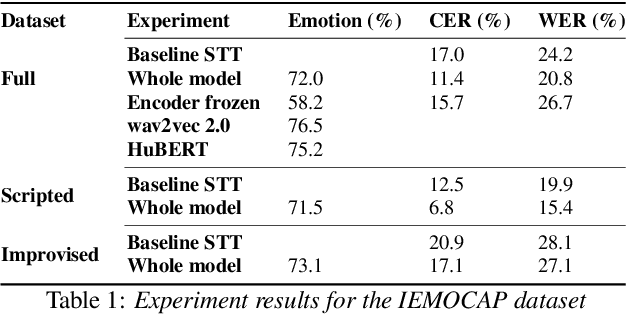
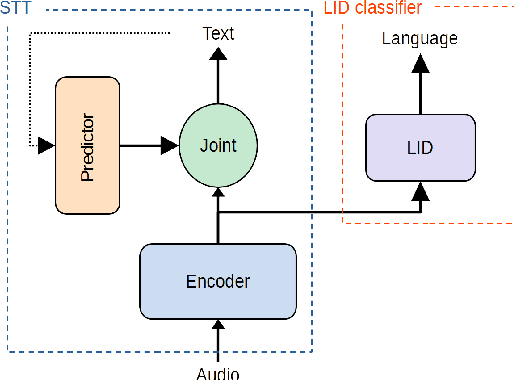
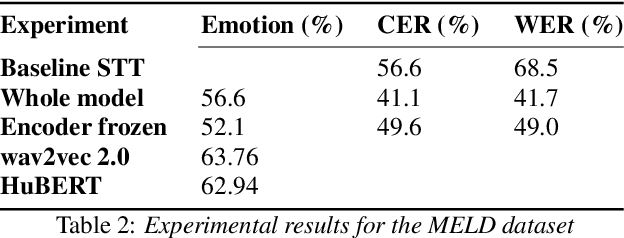
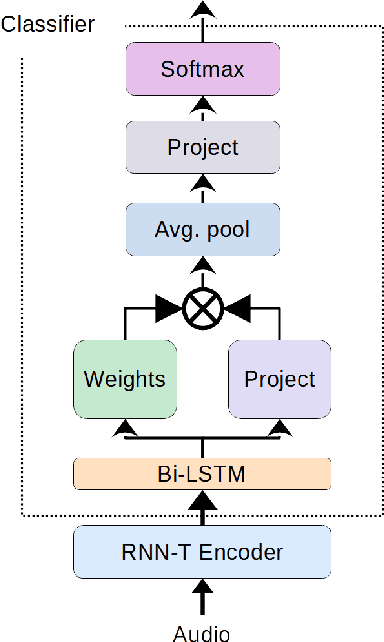
Abstract:Speech transcription, emotion recognition, and language identification are usually considered to be three different tasks. Each one requires a different model with a different architecture and training process. We propose using a recurrent neural network transducer (RNN-T)-based speech-to-text (STT) system as a common component that can be used for emotion recognition and language identification as well as for speech recognition. Our work extends the STT system for emotion classification through minimal changes, and shows successful results on the IEMOCAP and MELD datasets. In addition, we demonstrate that by adding a lightweight component to the RNN-T module, it can also be used for language identification. In our evaluations, this new classifier demonstrates state-of-the-art accuracy for the NIST-LRE-07 dataset.
Towards a Common Speech Analysis Engine
Mar 01, 2022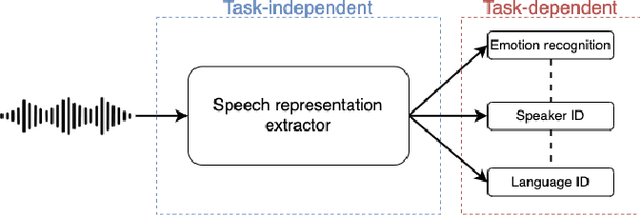
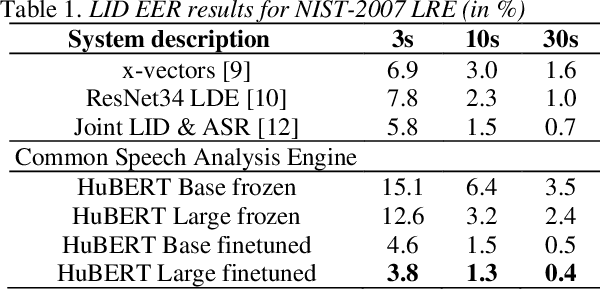


Abstract:Recent innovations in self-supervised representation learning have led to remarkable advances in natural language processing. That said, in the speech processing domain, self-supervised representation learning-based systems are not yet considered state-of-the-art. We propose leveraging recent advances in self-supervised-based speech processing to create a common speech analysis engine. Such an engine should be able to handle multiple speech processing tasks, using a single architecture, to obtain state-of-the-art accuracy. The engine must also enable support for new tasks with small training datasets. Beyond that, a common engine should be capable of supporting distributed training with client in-house private data. We present the architecture for a common speech analysis engine based on the HuBERT self-supervised speech representation. Based on experiments, we report our results for language identification and emotion recognition on the standard evaluations NIST-LRE 07 and IEMOCAP. Our results surpass the state-of-the-art performance reported so far on these tasks. We also analyzed our engine on the emotion recognition task using reduced amounts of training data and show how to achieve improved results.
Speech Emotion Recognition using Self-Supervised Features
Feb 07, 2022



Abstract:Self-supervised pre-trained features have consistently delivered state-of-art results in the field of natural language processing (NLP); however, their merits in the field of speech emotion recognition (SER) still need further investigation. In this paper we introduce a modular End-to- End (E2E) SER system based on an Upstream + Downstream architecture paradigm, which allows easy use/integration of a large variety of self-supervised features. Several SER experiments for predicting categorical emotion classes from the IEMOCAP dataset are performed. These experiments investigate interactions among fine-tuning of self-supervised feature models, aggregation of frame-level features into utterance-level features and back-end classification networks. The proposed monomodal speechonly based system not only achieves SOTA results, but also brings light to the possibility of powerful and well finetuned self-supervised acoustic features that reach results similar to the results achieved by SOTA multimodal systems using both Speech and Text modalities.
Speaker Normalization for Self-supervised Speech Emotion Recognition
Feb 02, 2022
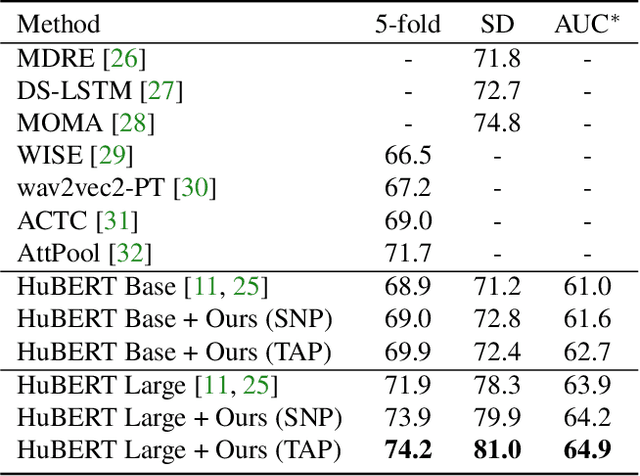
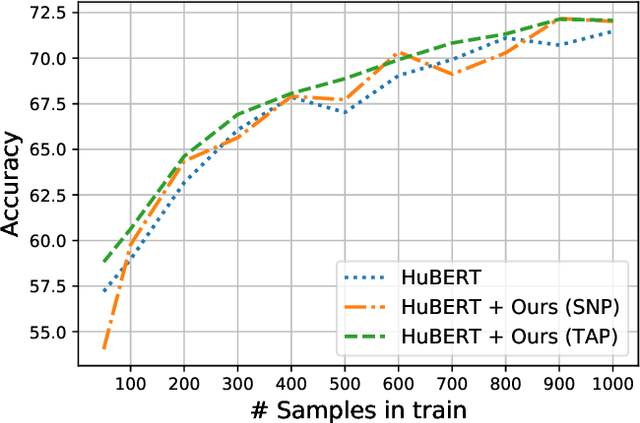
Abstract:Large speech emotion recognition datasets are hard to obtain, and small datasets may contain biases. Deep-net-based classifiers, in turn, are prone to exploit those biases and find shortcuts such as speaker characteristics. These shortcuts usually harm a model's ability to generalize. To address this challenge, we propose a gradient-based adversary learning framework that learns a speech emotion recognition task while normalizing speaker characteristics from the feature representation. We demonstrate the efficacy of our method on both speaker-independent and speaker-dependent settings and obtain new state-of-the-art results on the challenging IEMOCAP dataset.
Speak or Chat with Me: End-to-End Spoken Language Understanding System with Flexible Inputs
Apr 07, 2021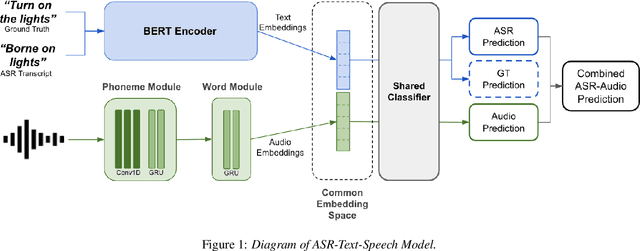
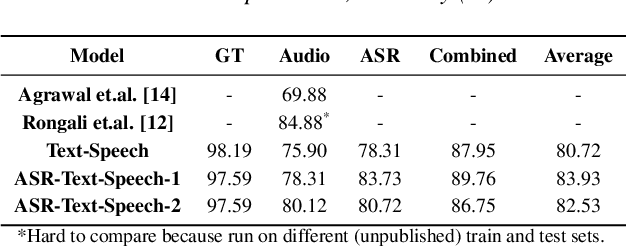
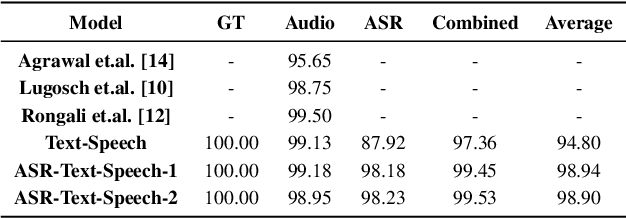
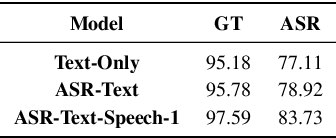
Abstract:A major focus of recent research in spoken language understanding (SLU) has been on the end-to-end approach where a single model can predict intents directly from speech inputs without intermediate transcripts. However, this approach presents some challenges. First, since speech can be considered as personally identifiable information, in some cases only automatic speech recognition (ASR) transcripts are accessible. Second, intent-labeled speech data is scarce. To address the first challenge, we propose a novel system that can predict intents from flexible types of inputs: speech, ASR transcripts, or both. We demonstrate strong performance for either modality separately, and when both speech and ASR transcripts are available, through system combination, we achieve better results than using a single input modality. To address the second challenge, we leverage a semantically robust pre-trained BERT model and adopt a cross-modal system that co-trains text embeddings and acoustic embeddings in a shared latent space. We further enhance this system by utilizing an acoustic module pre-trained on LibriSpeech and domain-adapting the text module on our target datasets. Our experiments show significant advantages for these pre-training and fine-tuning strategies, resulting in a system that achieves competitive intent-classification performance on Snips SLU and Fluent Speech Commands datasets.
End-to-end spoken language understanding using transformer networks and self-supervised pre-trained features
Nov 16, 2020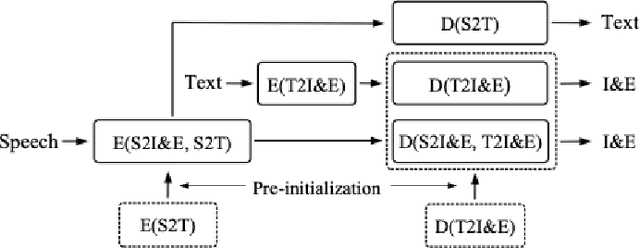
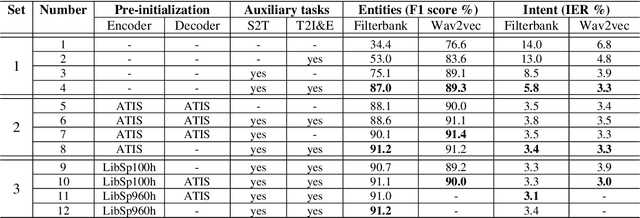


Abstract:Transformer networks and self-supervised pre-training have consistently delivered state-of-art results in the field of natural language processing (NLP); however, their merits in the field of spoken language understanding (SLU) still need further investigation. In this paper we introduce a modular End-to-End (E2E) SLU transformer network based architecture which allows the use of self-supervised pre-trained acoustic features, pre-trained model initialization and multi-task training. Several SLU experiments for predicting intent and entity labels/values using the ATIS dataset are performed. These experiments investigate the interaction of pre-trained model initialization and multi-task training with either traditional filterbank or self-supervised pre-trained acoustic features. Results show not only that self-supervised pre-trained acoustic features outperform filterbank features in almost all the experiments, but also that when these features are used in combination with multi-task training, they almost eliminate the necessity of pre-trained model initialization.
 Add to Chrome
Add to Chrome Add to Firefox
Add to Firefox Add to Edge
Add to Edge